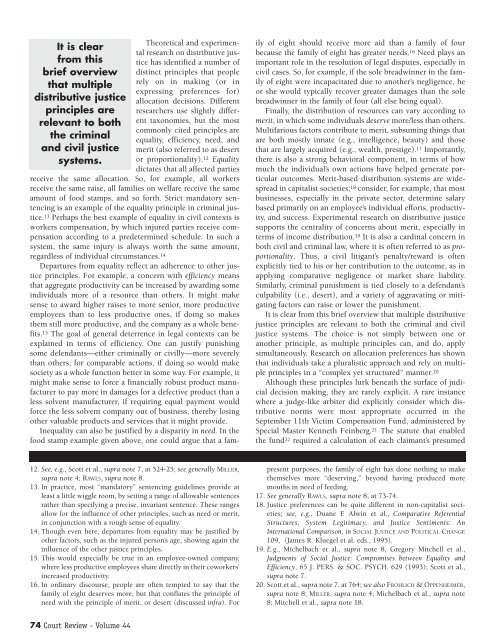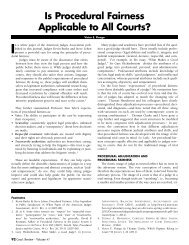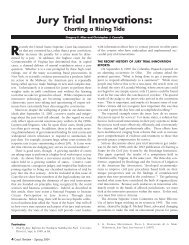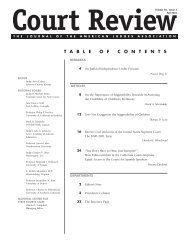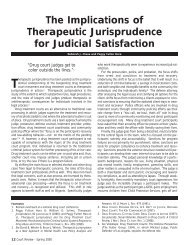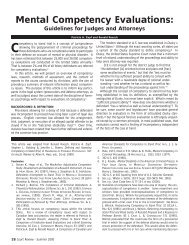Special Issue on Procedural Fairness - American Judges Association
Special Issue on Procedural Fairness - American Judges Association
Special Issue on Procedural Fairness - American Judges Association
- No tags were found...
Create successful ePaper yourself
Turn your PDF publications into a flip-book with our unique Google optimized e-Paper software.
It is clearfrom thisbrief overviewthat multipledistributive justiceprinciples arerelevant to boththe criminaland civil justicesystems.Theoretical and experimentalresearch <strong>on</strong> distributive justicehas identified a number ofdistinct principles that peoplerely <strong>on</strong> in making (or inexpressing preferences for)allocati<strong>on</strong> decisi<strong>on</strong>s. Differentresearchers use slightly differenttax<strong>on</strong>omies, but the mostcomm<strong>on</strong>ly cited principles areequality, efficiency, need, andmerit (also referred to as desertor proporti<strong>on</strong>ality). 12 Equalitydictates that all affected partiesreceive the same allocati<strong>on</strong>. So, for example, all workersreceive the same raise, all families <strong>on</strong> welfare receive the sameamount of food stamps, and so forth. Strict mandatory sentencingis an example of the equality principle in criminal justice.13 Perhaps the best example of equality in civil c<strong>on</strong>texts isworkers compensati<strong>on</strong>, by which injured parties receive compensati<strong>on</strong>according to a predetermined schedule. In such asystem, the same injury is always worth the same amount,regardless of individual circumstances. 14Departures from equality reflect an adherence to other justiceprinciples. For example, a c<strong>on</strong>cern with efficiency meansthat aggregate productivity can be increased by awarding someindividuals more of a resource than others. It might makesense to award higher raises to more senior, more productiveemployees than to less productive <strong>on</strong>es, if doing so makesthem still more productive, and the company as a whole benefits.15 The goal of general deterrence in legal c<strong>on</strong>texts can beexplained in terms of efficiency. One can justify punishingsome defendants—either criminally or civilly—more severelythan others, for comparable acti<strong>on</strong>s, if doing so would makesociety as a whole functi<strong>on</strong> better in some way. For example, itmight make sense to force a financially robust product manufacturerto pay more in damages for a defective product than aless solvent manufacturer, if requiring equal payment wouldforce the less solvent company out of business, thereby losingother valuable products and services that it might provide.Inequality can also be justified by a disparity in need. In thefood stamp example given above, <strong>on</strong>e could argue that a familyof eight should receive more aid than a family of fourbecause the family of eight has greater needs. 16 Need plays animportant role in the resoluti<strong>on</strong> of legal disputes, especially incivil cases. So, for example, if the sole breadwinner in the familyof eight were incapacitated due to another’s negligence, heor she would typically recover greater damages than the solebreadwinner in the family of four (all else being equal).Finally, the distributi<strong>on</strong> of resources can vary according tomerit, in which some individuals deserve more/less than others.Multifarious factors c<strong>on</strong>tribute to merit, subsuming things thatare both mostly innate (e.g., intelligence, beauty) and thosethat are largely acquired (e.g., wealth, prestige). 17 Importantly,there is also a str<strong>on</strong>g behavioral comp<strong>on</strong>ent, in terms of howmuch the individual’s own acti<strong>on</strong>s have helped generate particularoutcomes. Merit-based distributi<strong>on</strong> systems are widespreadin capitalist societies; 18 c<strong>on</strong>sider, for example, that mostbusinesses, especially in the private sector, determine salarybased primarily <strong>on</strong> an employee’s individual efforts, productivity,and success. Experimental research <strong>on</strong> distributive justicesupports the centrality of c<strong>on</strong>cerns about merit, especially interms of income distributi<strong>on</strong>. 19 It is also a cardinal c<strong>on</strong>cern inboth civil and criminal law, where it is often referred to as proporti<strong>on</strong>ality.Thus, a civil litigant’s penalty/reward is oftenexplicitly tied to his or her c<strong>on</strong>tributi<strong>on</strong> to the outcome, as inapplying comparative negligence or market share liability.Similarly, criminal punishment is tied closely to a defendant’sculpability (i.e., desert), and a variety of aggravating or mitigatingfactors can raise or lower the punishment.It is clear from this brief overview that multiple distributivejustice principles are relevant to both the criminal and civiljustice systems. The choice is not simply between <strong>on</strong>e oranother principle, as multiple principles can, and do, applysimultaneously. Research <strong>on</strong> allocati<strong>on</strong> preferences has shownthat individuals take a pluralistic approach and rely <strong>on</strong> multipleprinciples in a “complex yet structured” manner. 20Although these principles lurk beneath the surface of judicialdecisi<strong>on</strong> making, they are rarely explicit. A rare instancewhere a judge-like arbiter did explicitly c<strong>on</strong>sider which distributivenorms were most appropriate occurred in theSeptember 11th Victim Compensati<strong>on</strong> Fund, administered by<str<strong>on</strong>g>Special</str<strong>on</strong>g> Master Kenneth Feinberg. 21 The statute that enabledthe fund 22 required a calculati<strong>on</strong> of each claimant’s presumed12. See, e.g., Scott et al., supra note 7, at 524-25; see generally MILLER,supra note 4; RAWLS, supra note 8.13. In practice, most “mandatory” sentencing guidelines provide atleast a little wiggle room, by setting a range of allowable sentencesrather than specifying a precise, invariant sentence. These rangesallow for the influence of other principles, such as need or merit,in c<strong>on</strong>juncti<strong>on</strong> with a rough sense of equality.14. Though even here, departures from equality may be justified byother factors, such as the injured pers<strong>on</strong>’s age, showing again theinfluence of the other justice principles.15. This would especially be true in an employee-owned company,where less productive employees share directly in their coworkers’increased productivity.16. In ordinary discourse, people are often tempted to say that thefamily of eight deserves more, but that c<strong>on</strong>flates the principle ofneed with the principle of merit, or desert (discussed infra). Forpresent purposes, the family of eight has d<strong>on</strong>e nothing to makethemselves more “deserving,” bey<strong>on</strong>d having produced moremouths in need of feeding.17. See generally RAWLS, supra note 8, at 73-74.18. Justice preferences can be quite different in n<strong>on</strong>-capitalist societies;see, e.g., Duane F. Alwin et al., Comparative ReferentialStructures, System Legitimacy, and Justice Sentiments: AnInternati<strong>on</strong>al Comparis<strong>on</strong>, in SOCIAL JUSTICE AND POLITICAL CHANGE109, (James R. Kluegel et al. eds., 1995).19. E.g., Michelbach et al., supra note 8, Gregory Mitchell et al.,Judgments of Social Justice: Compromises between Equality andEfficiency, 65 J. PERS. & SOC. PSYCH. 629 (1993); Scott et al.,supra note 7.20. Scott et al., supra note 7, at 764; see also FROHLICH & OPPENHEIMER,supra note 8; MILLER, supra note 4; Michelbach et al., supra note8; Mitchell et al., supra note 18.74 Court Review - Volume 44


